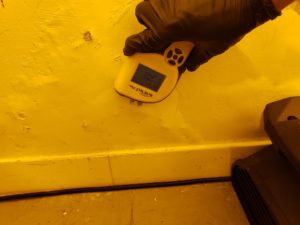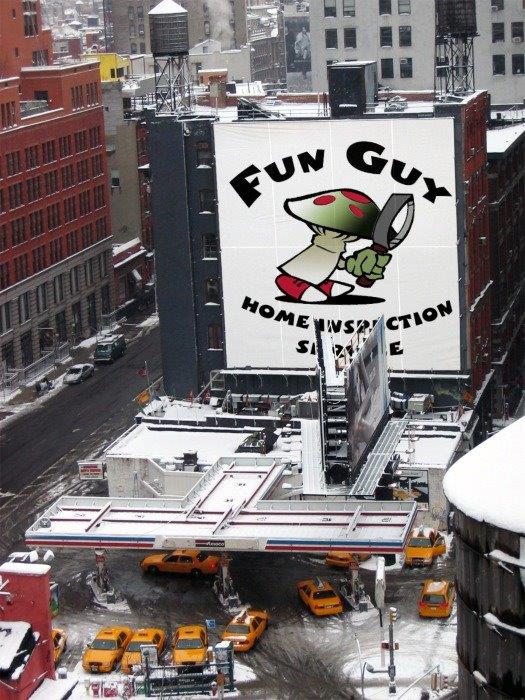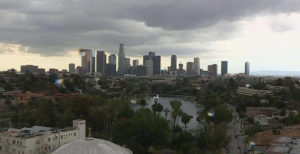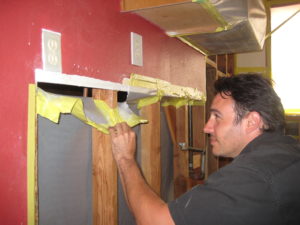Rains, Water Intrusion, and Mold Growth: Damage and Danger
In many parts of the US, rain is a fairly consistent phenomenon. Some months may bring more, others less, but by and large, liquid precipitation is spread out throughout the year. For more arid regions, like southern California, rain can be hard to come by during the late spring, entirety of summer, and all of the fall, too. Indeed, the rainy season, which runs from December to April officially, is the time where most areas of southern California receive more than 90% of their annual rainfall total. December was certainly quite wet throughout much of the area, and, historically, February is the month when the most rain tends to fall.
With that in mind, it seemed like the perfect time to discuss rain in the context of getting into your home, causing water damage, and the dangers of subsequent mold growth. It’s not too late to take steps to avoid water intrusion into your home. Knowing what to do when a leak or intrusion event does occur is equally critical, since the proper response and steps can help to limit the long-term damage and danger.
So, let’s take a brief look at the problems with rain, how it causes water intrusion, leads to water damage, and can cause mold growth. We’ll then address some of the signs and symptoms of mold growth, so that you can spot it for yourself. The health consequences of mold exposure will also be discussed. Finally, we’ll highlight the need for inspections when you suspect mold growth, and then touch on some of the remediation options to remove any water-damaged materials and mold growth from your home.
A brief disclaimer before we begin is in order, however. While much of the advice in this guide will be applicable anywhere in the US (and largely around the world, for that matter), some specific aspects of rain patterns and water intrusion we’ll mention specifically are in reference to the weather patterns that occur in southern California – our primary service area. So please keep that in mind, and adapt any strategies or information you may take away from this guide for your own climate and weather environment.
The Trouble with Rain
Rain is, of course, essential for plants and animals alike. It’s the primary outlet in the water cycle that feeds into our drinking water, irrigation systems for crops, and so on. Steady, occasional rain – even if sometimes intense or severe – is usually not much of a problem. Flash flooding, on the other hand – especially the kind that can occur after months of drought or dryness, can be quite problematic in a number of different ways.
For one thing, rain that only tends to happen during one specific time of year, and may only be severe or heavy during that time of year, makes it very easy for cracks, leaks, and other compromises in your home structure to go unnoticed during the dry period. This suddenly becomes apparent when the rainy season gets here, however, and you can go from not realizing there’s a problem to having a massive leaky roof, leaky foundation, or being inundated with water in a matter of minutes.
Another aspect of this rain pattern that can be problematic is that it can trigger flash flooding, overflowing drainage routes, and even mudslides. All of these are more likely in areas that receive little to no rain for large portions of the year, then get drenched with downpours during the rainy season. Needless to say, none of those consequences are ideal from the standpoint of a homeowner, and clear vectors for not only leaks, but actual floods and physical damage to your home.
In fact, any water getting into your home in an uncontained fashion is technically water intrusion, no matter where it comes from – even from a leaky pipe. Likewise, no matter the source, it is a cause for concern, and can lead to water damage and mold growth.
How Rain Causes Water Intrusion into Your Home
There are many ways in which rain can find its way into your home as water intrusion – far too many to address every one of them in this guide. That’s also part of the point – water, with the help of gravity, has a tendency to find its way through whatever cracks, holes, crevices, or other pathways may exist in and around your home. However, there are some common pathways that can be found in the vast majority of water damage cases, which we’ve outlined below.
- Leaky roofing, often due to missing, damaged, or compromised shingles, deteriorated lumber, wear and tear, and aging.
- Overflowing gutters or downspouts, usually due to clogs, which can spread standing water around porches, siding, foundations, and similar.
- Molding, trim, and other small details that are part of the exterior finish of the home, which may become damaged by animal activity, broken away due to weather (such as winds), or deteriorate due to sun exposure or normal wear and tear, opening up new pathways for water to enter the home.
- Windows that are unintentionally left open or not fully closed during a rain storm.
- Windows, doors, and other openings with seals that have become compromised, often from sun exposure over time.
- Foundations or slabs built with incorrect gradients around the home or a gradient that has changed over time, allowing water to flow towards, rather than way, from the home.
- Cracks and leaks in the foundation, subflooring, or other structural parts of the base of the home, with or without a basement, that allow rainwater to penetrate due to ground pressure, as well as water naturally found underground that may migrate towards and into these same structures.
- Floods, high wind, and other catastrophic events which may cause physical damage to the home, such as loss of a roof, siding, a tree limb through a portion of the home, etc., can quite naturally also allow water into the home.
Note that for the purposes of this guide, we’re just talking about rain water intrusion from the outside – not leaky pipes, overflowing toilets, clogged drains, and other causes that allow water damage and mold growth from inside the home. While these are also important to address, and can be just as dangerous, that’s really a topic for another article entirely.
Direct Water Damage

One of the two primary ways in which water intrusion causes problems within your home is through direct water damage. Many materials that are used in the construction or furnishing of a home do not do well with water exposure. Things like drywall, ceiling tiles, floor tiles and other flooring, insulation, and similar may become permanently damaged just from the inflow of water. Many forms of home flooring, including carpet, many synthetics and laminates, and even hardwood can become temporarily or permanently deformed and unusable after water exposure. This is distinct and separate from any kind of mold growth that can occur over time, which we’ll address in a moment.
Other forms of water damage can include aesthetic problems like bubbling paint, which is minor in the grand scheme but can be costly to repair. Water flowing into or through electrical conduits, ceiling fixtures, switches, and similar is of course a much more serious problem, and can lead to shocks, shorts, fires, and fried electronics and wiring. The same holds true for water intrusion into vent pipes that link to clothes dryers or bathroom ventilation fans, which can quickly become non-functional.
Mold Growth – The Hidden Danger from Water Intrusion
The hidden danger from water intrusion takes a bit more time to develop, and isn’t classified as direct water damage – mold growth. When  humidity levels are high and temperatures are right, mold can grow at an astounding rate inside enclosed spaces. Water leaks from rainfall, through all of the pathways and vectors discussed above, are a perfect way for water to get into an otherwise sealed and secured home, and sit and fester. Without adequate ventilation, many areas – behind drywall, in ceilings and under floors, for instance – become the perfect moist environment for mold to proliferate.
humidity levels are high and temperatures are right, mold can grow at an astounding rate inside enclosed spaces. Water leaks from rainfall, through all of the pathways and vectors discussed above, are a perfect way for water to get into an otherwise sealed and secured home, and sit and fester. Without adequate ventilation, many areas – behind drywall, in ceilings and under floors, for instance – become the perfect moist environment for mold to proliferate.
Mold spores naturally exist in the air all around us, but it takes the right set of conditions – high humidity, roughly room temperature, and poor airflow – to really allow them to take hold and set up shop, as it were, growing colonies and reproducing. Depending on the kind of water intrusion or damage that has occurred, mold growth may or may not be visible from within the home, but that doesn’t mean it’s not present – or that it’s not dangerous if left untreated.
Signs and Symptoms of Mold Growth
Mold growth can sometimes be blatantly obvious to homeowners and professionals alike, whereas in other cases, it remains hidden and undetected until health consequences develop. Still other cases see some of the characteristic symptoms of a mold growth problem, without visual appearance of mold in any accessible spaces in the home (such as when mold is growing in crawlspace, subflooring, drywall, and similar). Whatever the case may be, there are some basic signs and symptoms that can be used to indicate you might have a mold growth problem. These include:
- Humidity levels in the home or area of the home in excess of 50%
- Recent rains, flooding, or water damage to the home
- Visible signs of water damage, such as discolored walls, floors, bubbling paint, etc.
- Small discoloration patches, in a range of colors, which may appear furry or matte, especially if they seem to be increasing, or are found in areas of recent water intrusion
- An odor of mildew or rot occurring in the home, either in specific rooms or areas, or when your heating or cooling system is activated
- Peeling wallpaper, like bubbling paint, is a sign of water damage, and likely a breeding ground for mold
- Any noticeable feeling of dampness of any of the building materials or finishing materials within the home
Naturally, some of these signs can be a bit elusive, and it can be hard to distinguish between causes for others – sometimes, peeling or damaged wallpaper is just old and damaged, and not signs of mold growth or water damage, for instance. That’s why professional mold inspection companies exist, as we’ll discuss below. But first, let’s talk about the consequences of mold growth – why it’s bad for you and your family – before we get into what you can do about it.
Health Consequences
Mold growth that goes untreated can cause a number of negative health consequences and health problems for the people who live in the home. In addition to lowering the home value, and damaging various materials, surfaces, and so on in the home, the health effects are by far the biggest concern. The exact pathology will vary by individual and the type(s) of mold that may be present. However, many people who suffer from prolonged mold exposure – especially those who have pre-existing respiratory, allergy, or compromised immune system conditions – can develop a range of health symptoms, including:
- Fatigue/feeling of always being tired
- Allergic reactions or allergy symptoms, including itchy and red skin, watery or itchy eyes, sneezing, coughing, stuffed nose, and similar
- Respiratory symptoms, such as worsening asthma, difficulty breathing, a cough that won’t go away, etc.
- Feeling sick or run down all the time
- Dry, scaly skin, development of irritation or a rash, or other skin complaints
- Sinus symptoms, such as sinus infections, pain, swelling, etc.
- Stomach pain or digestive issues are less common, but have been reported – especially with molds giving off mycotoxins, a toxic byproduct of their metabolism
- A fever can develop among some people who are exposed to mold in the home
- Prolonged exposure and/or more exotic types of mold, especially in people who are already compromised immunologically, can cause far more severe reactions, up to and including coma or death, though this is generally rare
Mold Inspection and Remediation
When you have visible water damage, or suspect water damage or mold growth may be at work
in your home, then it’s time to call a professional. Mold inspection companies can use their knowledge and equipment to detect mold growing in the home. They know where mold is most likely to grow, all about the environment mold needs to reproduce, and have equipment to measure humidity, temperature, airflow, and more. They can take swabs of suspected mold in the home, and get it tested by a lab, to identify what it is, if it’s dangerous, and help you to formulate a remediation or treatment plan.
Once you have confirmed that mold is growing in your home, preferably with lab tests, mold remediation is in order. Remediation companies will help by cleaning and treating affected areas, or by performing removal of materials that may be too far damaged or contaminated to clean effectively. Remediation can include a mix of removal, cleaning, ventilation, replacement, and other activities. Smaller mold growth issues can also be handled on a DIY basis for remediation, but it’s best to consult an expert, or at the very least have an inspection. Too often, the tiny mold problem you think you may have is actually much more severe and widespread – just not wholly visible.
[wpforms id=”52″]
Professional Mold Inspections from FunGuy Inspections
If you live in the greater Los Angeles area, and suspect or are concerned about mold growth or water damage in your home, then you need a professional mold inspection. FunGuy Inspections is one of the leading inspection companies in the area, offering mold and other home hazard inspections. They’re reliable, professional, and affordable, with both residential and commercial clients across the greater Los Angeles area.
FunGuy Inspections are experts in mold inspection, testing, and corrective action planning. They use the latest equipment, methods, and their years of experience to assess and inspect structures for water intrusion, the intrusion vectors, and any mold growth that may be present. If mold is found, they can swab it and send it off to the lab for analysis, to confirm it is mold, along with the species. This feeds into the remediation plan, and will allow you to coordinate with a remediation contractor to resolve your problem.
Unlike some mold inspection companies, FunGuy Inspections is independent, and does not directly offer remediation services. As a result, their only vested interest is in helping you identify the problem, the root cause, and provide you with information for a remediation solution. They have no financial interest in up-selling you on remediation services, and no conflicts of interest as a result.
All of this means that when you choose FunGuy Inspections, before or after heavy rains, water damage, or suspected mold growth, you’re going to get professional service, results backed by science, and a definitive answer on the status of mold growth in your home. In short, you get your money’s worth, and – more importantly – you get the peace of mind knowing if rain water has wreaked havoc in your home, or if you’ve made it through the rainy season safely for another year.
[wpforms id=”52″]



